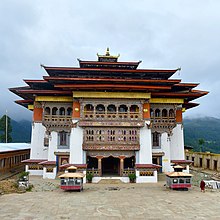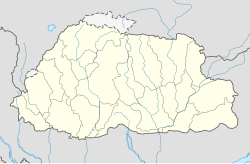| Gangteng Monastery Gangteng Gönpa Gangteng Sangngak Chöling | |
|---|---|
 Gangteng Monastery | |
| Religion | |
| Affiliation | Tibetan Buddhism |
| Festivals | Tshechu and Crane Festivals |
| Leadership | Rigdzin Kunzang Pema Namgyal |
| Location | |
| Location | Wangdue Phodrang District, Bhutan |
| Geographic coordinates | 27°30′N 90°10′E / 27.500°N 90.167°E |
| Architecture | |
| Style | Bhutanese Architecture |
| Founder | Gyalsé Pema Thinley |
| Date established | In 1613 by Gyalsé Rinpoche Gangteng Tulku Rigdzin Pema Tinley (1564–1642) |
Gangteng Monastery (Dzongkha: སྒང་སྟེང་དགོན་པ ), also known as Gangtey Gonpa or Gangtey Monastery, is a monastery of Nyingmapa school of Tibetan Buddhism, the main seat of the Pema Lingpa tradition,[1] located in the Wangdue Phodrang District in central Bhutan. The monastery, also known by the Gangten village that surrounds it, is in the Phobjikha Valley where winter visitors – the black-necked cranes – visit central Bhutan to roost, circling the monastery three times on arrival and repeating this circling when returning to Tibet.[2] The monastery's history traces to the early 17th century and back to the prophecies made by the terton (treasure finder) Pema Lingpa in the late 15th century.[3][4]
The monastery is one of the main seats of the religious tradition based on Pema Lingpa's revelations and one of the two main centres of the Nyingmapa school of Buddhism in the country.[5]
A Nyingma monastic college or shedra, Do-ngag Tösam Rabgayling, has been established above the village.[5]
The descent of the first king of Bhutan, Gongsar Ugyen Wangchuck of the Wangchuck Dynasty of Bhutan, which continues to rule Bhutan is traced to the clan of the Dungkhar Choje, a subsidiary of the clan of Khouchung Choje whose founder was Kunga Wangpo, the fourth son of Pema Lingpa.[6]
- ^ "NGA GeoName Database". National Geospatial-Intelligence Agency. Archived from the original on 2008-06-08. Retrieved 2008-07-05.
- ^ Train (2003), pp. 294–295.
- ^ Brown (2009), pp. 152–154.
- ^ "Biodiversity Action Plan 2009" (PDF). UNDP Org. Archived from the original (PDF) on 2012-12-03. Retrieved 2010-08-24.
- ^ a b Gangteng (2008), pp. 25–27.
- ^ Aris (2016), p. 105.
